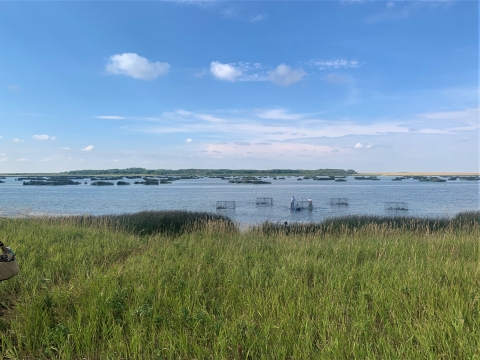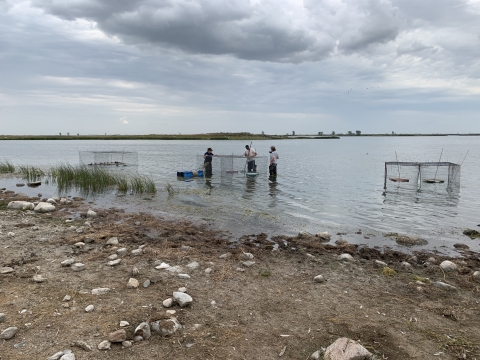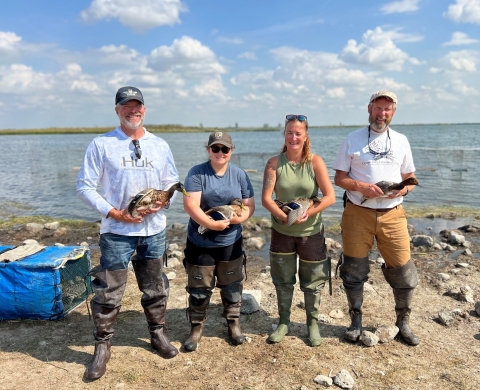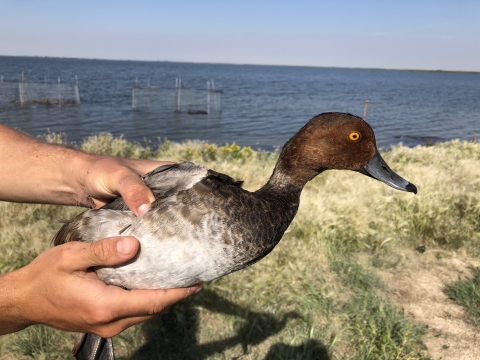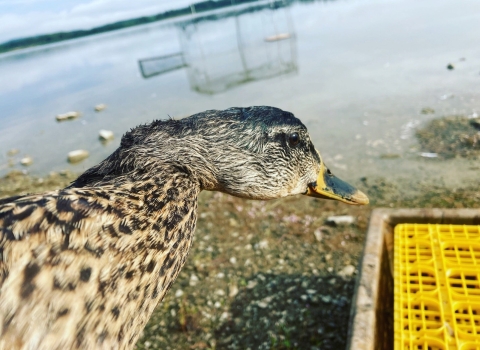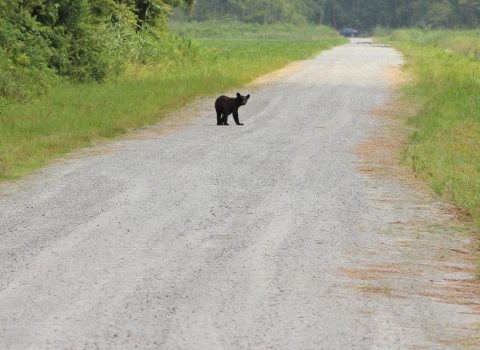The 2022 waterfowl banding season in central Saskatchewan was one for the record books in many ways! For this second-time waterfowl bander, it was a chance to shatter last year’s record of total ducks banded and sharpen my waterfowl identification skills. However, amidst our goal to lead a successful waterfowl banding season, our 4-person bird banding team had to face some extreme weather with intense heat and thunderstorms. As a native Floridian I can assure you I am rather accustomed to those weather phenomena, but I honestly didn’t expect to encounter them so far north!
Our crew quickly realized this year’s bird banding season would be different and we could leave the hoodies, sock hats, and coats packed away. In true Floridian style, I even brought my winter gloves and enough flannel to open my own outdoors store! Instead of dressing in layers each morning, our first task was to check the air moisture comfort and temperature ratio measurement – our neighbor’s to the north call this the humidex. However, I had never heard of such a measurement but it turns out that this term has been used in Canada since 1965. Basically, it’s an index number used by meteorologists in a similar way Americans use the heat index. The humidex is a scale running from 20-45+, with 20 signifying little to no discomfort and 45+ signifying great discomfort and dangerous health concerns. Our bird banding crew never saw the “little discomfort” stage during the entire banding season.
Despite the consistent heat and humidity, our crew set about to the task at hand. With successful scouting work by the crew leader and fellow pilot-biologist, Walt Rhodes, we were able to quickly deploy swim-in traps and get to it! Our Canadian partners were always there to help with every step of the bird banding and trapping process. A local farmer set up a sweet grain auger system for us to fill the bait bags to avoid stepping inside a dangerously hot grain bin. Canadian Wildlife Service staff were with us along the journey including helping us complain about the unusually hot and humid conditions! Nevertheless, as a good team does, we persevered and banded a lot of ducks!
As the days went on, I quickly learned another new term, loonie, which is used to measure the size of the hail stones headed our way! A typical loonie is about the size of the $1 Canada coin featuring an engraving of a common loon. The coin is almost exactly the same diameter as a U.S. quarter. Whereas Americans typically measure hailstones using sports ball analogies, such as golf ball-sized hail or even softball-sized, our friends to the north use loonies. Thankfully, waiting on the onslaught of inbound loonies and heavy lightning in our vehicles was not a daily occurrence. However, the occasional violent storm was a welcome break from the oppressing daily sun and humidity.
Along with our normal daily routine of checking bird traps, banding ducks, and rebaiting, we had the pleasure of working with videographer, Doug Canfield, from the National Conservation Training Center. Doug is collaborating with our team to produce an introductory waterfowl banding video. This video will be used to better inform and instruct other U.S. Fish and Wildlife Service biologists on bird banding efforts. Since viewers will not be able to feel the intense heat and humidity, nor see us huddled in trucks during severe storms, I am hopeful the video will encourage more biologists to join bird banding in future years.
Even with extreme weather conditions, the beauty on the vast Saskatchewan prairie could not be diminished. Arriving to the presence of a dizzying array of passerines assembling before their abrupt mass exodus to the south and watching both the sandhill and whooping cranes do the same was a daily delight for our entire crew! The staccato trill of the cranes provided a pleasant background serenade as we carefully placed bird bands on blue-winged teal, Northern pintails, mallards, redheads, and even a few canvasback. The vastness of the Saskatchewan prairie was awe inspiring and humbling at the same time. The beauty of the prairie seemed to stretch for miles. Though today’s prairie habitat mostly consists of canola and wheat I couldn’t help but think what it must have been like prior to the European expansion. Remnants of diverse grasses and forbes in nearby ditches and abandoned homesteads provided some clues as to what the world’s largest biome could have looked like not that long ago.
Given some of the obstacles during the bird banding season, the true rewards of being on a banding crew are not only the number of ducks that are banded, or even the beauty of the prairies, but above all is the relationships that are built with your teammates, Canadian Wildlife Service comrades, and local community members. There is something really special about long days outdoors catching wildlife and working with others on a small team that develop meaningful relationships and friendships. It awakened a part of my humanity and allowed my mind to focus less on the modern world of emails, laptops, iPhones, Teams calls, and apps. Chasing tasks on electronic screens cannot replace chasing wildlife in the wild. Engaging in this ancestral chase alongside dedicated biologists for a common goal to benefit wildlife populations for future generations is the greatest job on earth! I am most grateful for my coworkers, our shared experiences and the myriad of benefits for all. I was even able to forget about the “humidex” and redirect my focus on the “Life-idex” and I felt fully ALIVE!


